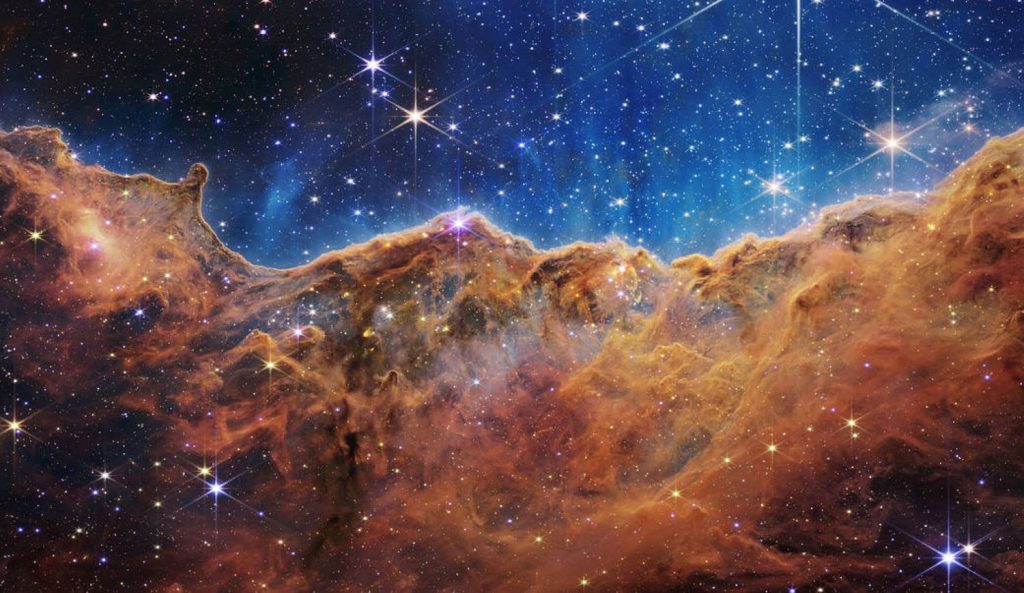‘This Is Just The First’

Massive Galaxy Cluster Discovered by UH Researchers Among Inaugural Images Captured by James Webb Space Telescope
One of the first full-color images taken with NASA’s James Webb Space Telescope on Monday, July 11, was of an enormous cluster of galaxies originally discovered by researchers at the University of Hawai‘i Institute for Astronomy.
The galaxy cluster captured in the image by the James Webb telescope is called SMACSJ0723, an exceptionally massive concentration of galaxies that was first pinpointed by Institute for Astronomy researchers nearly 20 years ago.

“Observational astronomy has a way of leaving us in awe and speechless, but (James Webb Space Telescope) truly ushers in a new era,” Harald Ebeling, senior faculty at the Institute for Astronomy and principal investigator of the Massive Cluster Survey, which identified the galaxy cluster, said in a UH press release. “All the super faint, dark-red tiny dots, as well as the much brighter, strangely shaped objects in this astounding image are extremely distant galaxies that no human eye has seen before.”
Ebeling added that the galaxy cluster is on the edge of the visible universe, brought within the reach of the James Webb telescope by the gravitational amplification of SMACSJ0723.
“We were delighted and honored to learn that one of ‘our’ clusters was chosen to be among the very first objects to be observed with (James Webb Space Telescope),” he said in the press release.
Galaxy clusters are the most massive objects in the universe held together by gravity and contain vast amounts of dark matter and diffuse gas. Tagged as a potentially extremely massive cluster by the Institute for Astronomy team, SMACSJ0723 was confirmed soon thereafter through observations performed with the European Southern Observatory’s 3.5-meter telescope in Chile.
“While much of the sky can be reached with the world-class facilities on Maunakea, some of our (Massive Cluster Survey) cluster candidates were just too far south. Fortunately astronomy is a collaborative effort,” MACS co-investigator Alastair Edge, deputy director at the Centre for Extragalactic Astronomy at Durham University in the United Kingdom, said in the press release.
Edge led measurements that placed SMACSJ0723 at a distance of more than 7 billion light years away from Earth. Institute for Astronomy alumnus Chris Mullis and Durham University alumnus Nathan Courtney were also part of Edge’s research team.
“The sheer size of these systems, and the fact that cluster studies yield insights into the properties of gas, galaxies and dark matter all in ‘one shot,’ have greatly helped to improve our understanding of the formation and evolution of the universe, from the Big Bang to the present day,” Ebeling said in the press release.
As a result, MACS clusters have been sought-after targets for numerous in-depth studies conducted with the Hubble Space Telescope and many other ground- and space-based astronomical facilities.
The unprecedented image of SMACSJ0723 is part of the telescope’s exclusive round of first science observations. It was revealed Monday during a ceremony at the White House, which included President Joe Biden and top NASA officials. Several more images were released Tuesday, July 12.
“We’re looking back more than 13 billion years,” NASA Administrator Bill Nelson said during the ceremony, according to a story by The Washington Post. “Light travels at 186,000 miles per second, and that light that you are seeing from one of those little specks, has been traveling for over 13 billion years.”
NASA and its partners have kept the first James Webb telescope images close during the initial sequence of observations, The Post said. The telescope orbits the sun about 1 million miles from Earth. It was launched last December.
“And by the way, we’re going back further,” Nelson said in The Post story. “Because this is just the first image. … We’re going back almost to the beginning.”
There also are plans for the James Webb telescope to study planets orbiting distant stars, seeking signs of possible habitability, including an atmosphere similar to Earth’s, The Post wrote.
“You’re going to see whether or not planets, because of the chemical composition that we can determine with this telescope, of their atmosphere, if those planets are habitable,” Nelson said in The Post story.
Technology developed and tested at the Institute for Astronomy and on Maunakea are behind the James Webb Space Telescope’s ability to gaze deeper into the cosmos than ever before.
Sixteen near-infrared sensors known as HAWAII-2RGs are part of the James Webb telescope’s science instruments, enabling it to capture near-infrared light from deep space, far surpassing the capability of the Hubble telescope.
These sensors are the culmination of years of research and development by UH Institute for Astronomy scientists and engineers. Early prototypes were developed and tested by UH astronomers Don Hall, Klaus Hodapp and Doug Simons, along with Institute for Astronomy instrumentation engineer Shane Jacobson.
Sponsored Content
Comments








